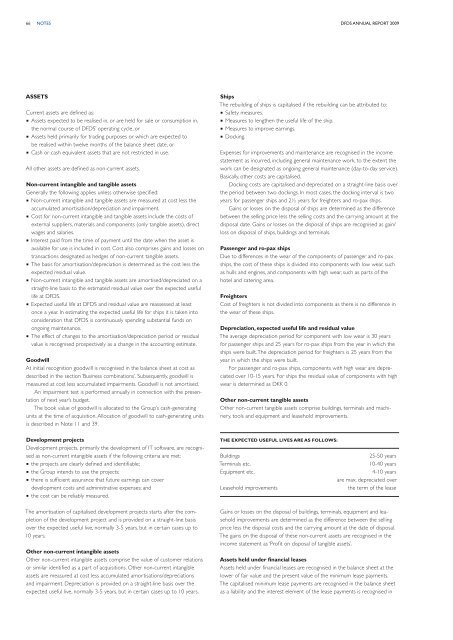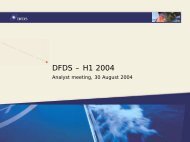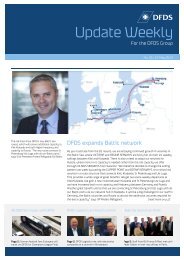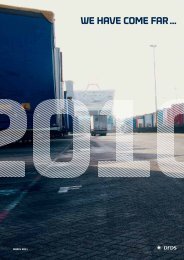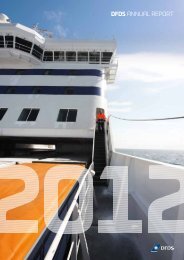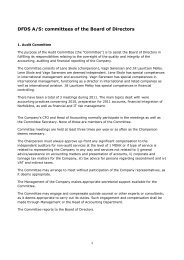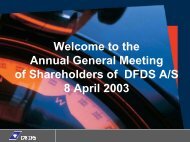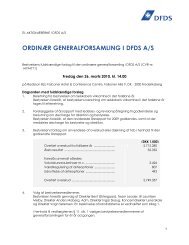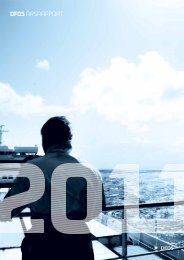English - DFDS
English - DFDS
English - DFDS
Create successful ePaper yourself
Turn your PDF publications into a flip-book with our unique Google optimized e-Paper software.
66 NOTEs<br />
<strong>DFDS</strong> annual report 2009<br />
Assets<br />
Current assets are defined as:<br />
n Assets expected to be realised in, or are held for sale or consumption in,<br />
the normal course of <strong>DFDS</strong>’ operating cycle, or<br />
n Assets held primarily for trading purposes or which are expected to<br />
be realised within twelve months of the balance sheet date, or<br />
n Cash or cash equivalent assets that are not restricted in use.<br />
All other assets are defined as non-current assets.<br />
Non-current intangible and tangible assets<br />
Generally the following applies unless otherwise specified:<br />
n Non-current intangible and tangible assets are measured at cost less the<br />
accumulated amortisation/depreciation and impairment.<br />
n Cost for non-current intangible and tangible assets include the costs of<br />
external suppliers, materials and components (only tangible assets), direct<br />
wages and salaries.<br />
n Interest paid from the time of payment until the date when the asset is<br />
available for use is included in cost. Cost also comprises gains and losses on<br />
transactions designated as hedges of non-current tangible assets.<br />
n The basis for amortisation/depreciation is determined as the cost less the<br />
expected residual value.<br />
n Non-current intangible and tangible assets are amortised/depreciated on a<br />
straight-line basis to the estimated residual value over the expected useful<br />
life at <strong>DFDS</strong>.<br />
n Expected useful life at <strong>DFDS</strong> and residual value are reassessed at least<br />
once a year. In estimating the expected useful life for ships it is taken into<br />
consideration that <strong>DFDS</strong> is continuously spending substantial funds on<br />
ongoing maintenance.<br />
n The effect of changes to the amortisation/depreciation period or residual<br />
value is recognised prospectively as a change in the accounting estimate.<br />
Goodwill<br />
At initial recognition goodwill is recognised in the balance sheet at cost as<br />
described in the section ‘Business combinations’. Subsequently, goodwill is<br />
measured at cost less accumulated impairments. Goodwill is not amortised.<br />
An impairment test is performed annually in connection with the presentation<br />
of next year’s budget.<br />
The book value of goodwill is allocated to the Group’s cash-generating<br />
units at the time of acquisition. Allocation of goodwill to cash-generating units<br />
is described in Note 11 and 39.<br />
Development projects<br />
Development projects, primarily the development of IT software, are recognised<br />
as non-current intangible assets if the following criteria are met:<br />
n the projects are clearly defined and identifiable;<br />
n the Group intends to use the projects;<br />
n there is sufficient assurance that future earnings can cover<br />
development costs and administrative expenses; and<br />
n the cost can be reliably measured.<br />
Ships<br />
The rebuilding of ships is capitalised if the rebuilding can be attributed to:<br />
n Safety measures.<br />
n Measures to lengthen the useful life of the ship.<br />
n Measures to improve earnings.<br />
n Docking.<br />
Expenses for improvements and maintenance are recognised in the income<br />
statement as incurred, including general maintenance work, to the extent the<br />
work can be designated as ongoing general maintenance (day-to-day service).<br />
Basically, other costs are capitalised.<br />
Docking costs are capitalised and depreciated on a straight-line basis over<br />
the period between two dockings. In most cases, the docking interval is two<br />
years for passenger ships and 2½ years for freighters and ro-pax ships.<br />
Gains or losses on the disposal of ships are determined as the difference<br />
between the selling price less the selling costs and the carrying amount at the<br />
disposal date. Gains or losses on the disposal of ships are recognised as gain/<br />
loss on disposal of ships, buildings and terminals.<br />
Passenger and ro-pax ships<br />
Due to differences in the wear of the components of passenger and ro-pax<br />
ships, the cost of these ships is divided into components with low wear, such<br />
as hulls and engines, and components with high wear, such as parts of the<br />
hotel and catering area.<br />
Freighters<br />
Cost of freighters is not divided into components as there is no difference in<br />
the wear of these ships.<br />
Depreciation, expected useful life and residual value<br />
The average depreciation period for component with low wear is 30 years<br />
for passenger ships and 25 years for ro-pax ships from the year in which the<br />
ships were built. The depreciation period for freighters is 25 years from the<br />
year in which the ships were built.<br />
For passenger and ro-pax ships, components with high wear are depreciated<br />
over 10-15 years. For ships the residual value of components with high<br />
wear is determined as DKK 0.<br />
Other non-current tangible assets<br />
Other non-current tangible assets comprise buildings, terminals and machinery,<br />
tools and equipment and leasehold improvements.<br />
The expected useful lives are as follows:<br />
Buildings<br />
Terminals etc.<br />
Equipment etc.<br />
Leasehold improvements<br />
25-50 years<br />
10-40 years<br />
4-10 years<br />
are max. depreciated over<br />
the term of the lease<br />
The amortisation of capitalised development projects starts after the completion<br />
of the development project and is provided on a straight-line basis<br />
over the expected useful live, normally 3-5 years, but in certain cases up to<br />
10 years.<br />
Other non-current intangible assets<br />
Other non-current intangible assets comprise the value of customer relations<br />
or similar identified as a part of acquisitions. Other non-current intangible<br />
assets are measured at cost less accumulated amortisations/depreciations<br />
and impairment. Depreciation is provided on a straight-line basis over the<br />
expected useful live, normally 3-5 years, but in certain cases up to 10 years.<br />
Gains or losses on the disposal of buildings, terminals, equipment and leasehold<br />
improvements are determined as the difference between the selling<br />
price less the disposal costs and the carrying amount at the date of disposal.<br />
The gains on the disposal of these non-current assets are recognised in the<br />
income statement as ‘Profit on disposal of tangible assets’.<br />
Assets held under financial leases<br />
Assets held under financial leases are recognised in the balance sheet at the<br />
lower of fair value and the present value of the minimum lease payments.<br />
The capitalised minimum lease payments are recognised in the balance sheet<br />
as a liability and the interest element of the lease payments is recognised in


